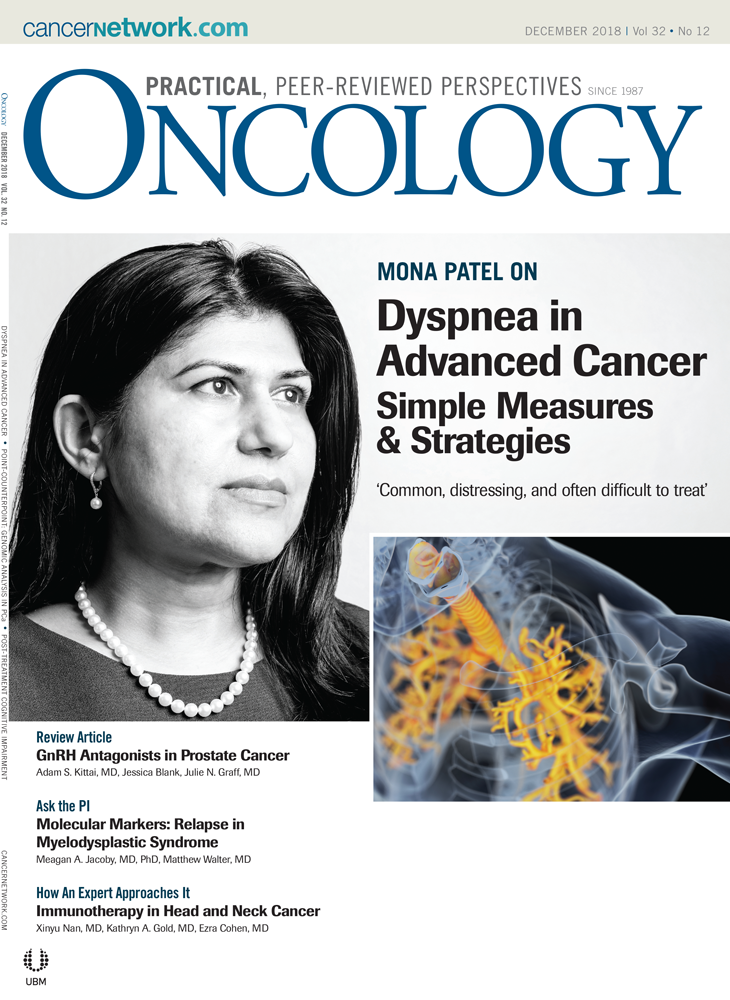Identifying Molecular Markers of Relapse in Myelodysplastic Syndrome
In this month's installment of Ask the PI, ONCOLOGY spoke with Meagan A. Jacoby, MD, PhD, and Matthew Walter, MD, about their findings and what they might mean for practicing oncologists.
Oncology (Williston Park). 32(12):627-9.

Meagan A. Jacoby, MD, PhD

Matthew Walter, MD

A study published in the New England Journal of Medicine this past September analyzed molecular strategies to monitor patients with myelodysplastic syndrome (MDS) at risk of relapse. The research also identified markers associated with a risk of progression following a potentially curative stem cell transplant. In this month's installment of Ask the PI, ONCOLOGY spoke with two authors of the study, Meagan A. Jacoby, MD, PhD, and Matthew Walter, MD, about their findings and what they might mean for practicing oncologists.
Q:For patients with MDS who have opted to undergo an allogeneic hematopoietic stem cell transplantation, are there currently ways to clinically or molecularly assess the risk of relapse before the transplant? Additionally, can tests monitor for relapse following transplantation?
DR. JACOBY: Yes, there are ways to look for predictors of relapse prior to a transplant. This is usually done via a scoring system, such as the International Prognostic Scoring System (IPSS) or the Revised International Prognostic Scoring System (IPSS-R). Both look at things like cytogenetics of the MDS cells, the number of blasts in the bone marrow, and the number of peripheral cytopenias. By looking at these factors, we can predict patients' overall survival and risk of developing a secondary acute myeloid leukemia based on which factors have been shown to be predictive for risk.
The other molecular factor that can often predict a poor outcome after transplant is the p53 gene. Patients with p53 mutations don't do as well after transplant as those without the mutation. In terms of monitoring for risk post-transplant, a bone marrow biopsy is conducted at milestones, including at day 30 and day 100. We then look at the morphology under the microscope, as well as the cytogenetics and the percentage of engraftment. If engraftment decreases or is not attained-what we call a mixed chimera-then the patient's risk of relapse is higher.
Q:In that context, can you tell us the setup of the mutation detection study that you and your colleagues conducted in these types of MDS patients and the question you were addressing?
DR. WALTER: Based on post-transplant monitoring, which Dr. Jacoby just mentioned, there are some limitations for morphology. In particular, when we look at a bone marrow biopsy and the morphology of the aspirate, we are often looking for the blast percentages in those samples. For MDS, we know that blast count can underrepresent the tumor burden that is present in patients. So, we wanted to come up with a technique that would be applicable to everyone. Another limitation of using cytogenetics, or fluorescence in situ hybridization (FISH), to look at molecular abnormalities is that those changes will be present in only a fraction of patients going into transplant.
Our goal was to use an assay that could be applicable to every patient with MDS and to utilize molecular markers to monitor tumor burden. We wanted to address the question of whether persistent molecular disease, detectable early after transplant-at day 30 or at day 100 after transplant-could provide prognostic information that was associated with outcome. Several DNA sequencing approaches could have been used: a gene panel approach or whole genome sequencing. However, each has limitations. In the end, we chose a middle ground, exome sequencing, to discover mutations prior to transplant. This method allowed us to detect mutations in almost every patient. Then, we simply genotyped those mutations 30 or 100 days after transplantation. Since we wanted a sequencing technique that was very sensitive after transplant, we incorporated the use of unique molecular indexes, which were ligated to DNA molecules, before we did the sequencing. This allowed us to get down to detecting one heterozygous mutant cell out of 100 cells in the bone marrow samples. Theoretically, this technique could go even lower, but we limited our approach to that level of sensitivity.
Q:What did you find in the study, and were any of the results particularly surprising?
DR. WALTER: Analyzing only single nucleotide variants allowed us to identify an average of 29 mutations per patient before transplantation. We then used a cutoff of detecting one mutant cell in 100 cells, and we classified a patient as having detectable tumor cells if we found at least one mutation above this threshold at day 30 or day 100. We found that mutant-positive patients had an increased risk of progression. At 1 year after transplant, those who had a mutation detectable at that level at 30 days after transplant had a fourfold higher risk of progression compared with those who were mutation-negative at that threshold. About 53% of patients with a mutation detectable at that level had progressed compared with 13% who didn't have a mutation detectable at that level. This also translated into worse progression-free survival in patients with mutations detectable at day 30. The largest effect, for the group of patients who were at highest risk of progression, was seen in individuals who received a reduced-intensity conditioning regimen compared with those who received myeloablative conditioning. Nearly all patients who received reduced-intensity conditioning and had a mutation detected at 30 days after transplant ended up progressing at some time point.
Q: What are some of the implications of these results?
DR. JACOBY: The major implication is that we can detect disease in patients who are destined to relapse at an earlier time than by traditional methods of bone marrow morphology and chimerism and engraftment studies. If we can identify a window in which we can intervene, we may be able to stop the impending progression. I think that will be the next step, or the next study, we would like to complete. If we can do this prospectively and in real time, we can get these milestone bone marrow biopsies and sequence them for every patient; then, if we can detect mutations, we can also evaluate what we can do in terms of an intervention. At this point, it is unclear exactly what the best intervention would be, but that needs to be studied. I would say that a clinical trial looking at the detection in real time in a clinically actionable timeframe for any mutations that are left after transplant is important.
Q:It sounds like more studies are needed before this type of mutational analysis could be used in the clinic. Are there any direct clinical applications for patients now, and would you like to add anything else on the future studies on how this mutational analysis could be used in the clinic?
DR. JACOBY: We are looking [at the risk of relapse] prior to transplant now with gene panels, although this is not quite as sensitive as the exome sequencing that we utilized in this study. Certainly, post-transplant, it is not routine to look for persistent mutations that have not been cleared. I think more studies are needed before this could become clinically routine and, as I said before, a prospective clinical trial evaluating tests at day 30 and day 100 to detect low-level persistent disease is needed.
DR. WALTER: The other thing to highlight is that we designed the study to try to detect mutations in every patient. We used a broader sequencing approach encompassing the exome, and this is currently not feasible to do clinically. I think that we need to go back and study whether we can use gene panel sequencing to achieve a similar result as we did here. We did address this in the publication by down-sampling the data to look at only 40 of the most recurrently mutated genes in MDS. When we did that, we found the same result. So, detection of mutations at day 30 after transplant remained prognostic for progression and progression-free survival. However, only 79% of the patients that we originally analyzed were able to be evaluated using the gene panel sequencing because those additional patients didn't have a mutation in one of those genes that we could follow after transplant. Because we used a paired-normal DNA sample from each patient to identify somatic mutations, we need to know whether the 40-gene panel using tumor-only sequencing is still feasible. Plus, we need to incorporate insertions and deletions, as well as structural variants present in each patient.
Finally, we need to think about how we are going to incorporate these molecular studies into the current standard of care, as well as into multiparameter flow cytometry, which is also being tested for its ability to detect residual tumor cells after transplant. Ultimately, as Dr. Jacoby mentioned, all of these things will need to be tested prospectively in a clinical trial to move to the next stage.
ABOUT THE STUDY
To access the complete study, please reference: Duncavage EJ, Jacoby MA, Chang GS, et al. Mutation clearance after transplantation for myelodysplastic syndrome. N Engl J Med. 2018;379: 1028-41.
Financial Disclosure: The authors have no significant financial interest in or other relationships with the manufacturer of any product or provider of any service mentioned in this article.
